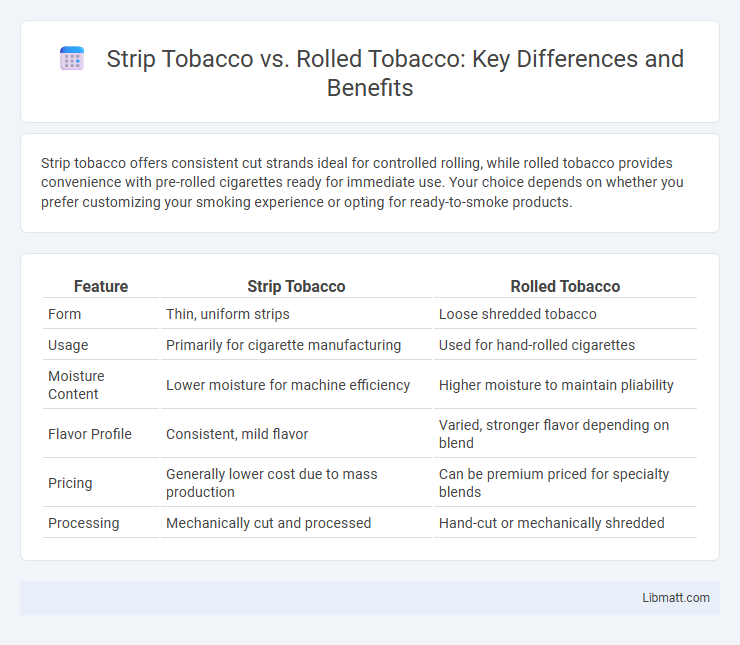Strip tobacco offers consistent cut strands ideal for controlled rolling, while rolled tobacco provides convenience with pre-rolled cigarettes ready for immediate use. Your choice depends on whether you prefer customizing your smoking experience or opting for ready-to-smoke products.
Table of Comparison
| Feature | Strip Tobacco | Rolled Tobacco |
|---|---|---|
| Form | Thin, uniform strips | Loose shredded tobacco |
| Usage | Primarily for cigarette manufacturing | Used for hand-rolled cigarettes |
| Moisture Content | Lower moisture for machine efficiency | Higher moisture to maintain pliability |
| Flavor Profile | Consistent, mild flavor | Varied, stronger flavor depending on blend |
| Pricing | Generally lower cost due to mass production | Can be premium priced for specialty blends |
| Processing | Mechanically cut and processed | Hand-cut or mechanically shredded |
Introduction to Strip Tobacco and Rolled Tobacco
Strip tobacco consists of finely cut tobacco leaves processed into uniform strips, commonly used in cigarette manufacturing for consistent burning and flavor release. Rolled tobacco refers to loose tobacco leaves rolled by hand or machine into cigarettes, offering a customizable smoking experience with varied leaf blends and moisture content. Both forms provide distinct textures and nicotine delivery methods, influencing smoker preference and consumption style.
Defining Strip Tobacco
Strip tobacco refers to finely cut and processed tobacco leaves that are typically sold in sheets or strips, designed for easy handling and consistent use in rolling cigarettes. Unlike loose or rolled tobacco, strip tobacco offers a uniform moisture content and particle size, enhancing even burning and better flavor retention. This form is especially popular among manufacturers and consumers who prefer to customize cigarette size and blend types without compromising tobacco quality.
Understanding Rolled Tobacco
Rolled tobacco, often used in hand-rolled cigarettes, consists of shredded tobacco leaves that offer a customizable smoking experience compared to strip tobacco, which is processed into uniform sheets for machine-made cigarettes. This form allows smokers to control the blend, density, and additives, impacting flavor and nicotine delivery. Understanding rolled tobacco involves recognizing its artisanal appeal and the variability in quality and composition that affects smoking satisfaction and health risks.
Key Differences Between Strip and Rolled Tobacco
Strip tobacco consists of thin, uniformly cut leaves designed for easy packing, while rolled tobacco is loose, shredded tobacco often hand-rolled or machine-rolled into cigarettes. Strip tobacco offers consistent moisture content and burn rate, enhancing smoking experience, whereas rolled tobacco can vary in texture and density, affecting flavor and burn time. Your choice depends on preference for convenience and uniformity with strip tobacco or a customizable, traditional approach with rolled tobacco.
Production Processes Compared
Strip tobacco undergoes a process where whole tobacco leaves are shredded into uniform strips using specialized machinery, ensuring consistency in texture and moisture content for mass production. Rolled tobacco typically involves cutting tobacco leaves into thin ribbons or strands, often with varying leaf blends and moisture levels, allowing for more traditional and artisanal rolling methods. Understanding these production differences can help you choose tobacco that matches your preferred smoking experience and quality standards.
Flavor and Smoking Experience
Strip tobacco offers a more consistent flavor profile due to uniform curing and cutting processes, resulting in a smoother and more predictable smoking experience. Rolled tobacco, often fresher and less processed, provides a richer and more robust flavor that can vary depending on the roll and tobacco blend. Your choice between strip tobacco and rolled tobacco directly influences the intensity and character of your smoking enjoyment.
Health Implications
Strip tobacco typically contains higher levels of nicotine and additives compared to rolled tobacco, increasing the risk of addiction and respiratory diseases. Rolled tobacco, often hand-rolled, may expose users to fewer chemical additives but still poses significant risks such as lung cancer, chronic bronchitis, and cardiovascular disease. Both forms of tobacco use contribute substantially to smoking-related morbidity and mortality worldwide.
Cost and Accessibility
Strip tobacco generally offers a more cost-effective option than rolled tobacco due to its bulk packaging and lower processing costs. Rolled tobacco often comes pre-packaged in smaller quantities, making it less accessible and more expensive per gram. You can save money and find greater availability by choosing strip tobacco for your smoking needs.
Popularity and Consumer Preference
Strip tobacco, commonly found in pre-cut form, appeals to consumers seeking convenience and consistent quality, while rolled tobacco attracts enthusiasts who prefer customization and a traditional smoking experience. Consumer preference often hinges on lifestyle and usage habits, with strip tobacco dominating urban markets due to its ease of use, and rolled tobacco maintaining strong loyalty among artisanal and budget-conscious smokers. Your choice between the two reflects a balance between practicality and personal ritual in tobacco consumption.
Conclusion: Choosing Between Strip and Rolled Tobacco
Choosing between strip tobacco and rolled tobacco depends on your preferences for convenience and customization. Strip tobacco offers pre-cut, uniform portions ideal for quick rolling, while rolled tobacco allows you to control the amount and compactness of your cigarette. Understanding these differences ensures you select the tobacco type that best suits your smoking style and experience.
Strip tobacco vs rolled tobacco Infographic

 libmatt.com
libmatt.com